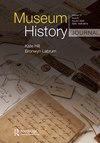Filling in the Picture: Nineteenth-Century Museums in Spanish and Portuguese America
IF 0.2
Q3 HISTORY
引用次数: 5
Abstract
This special issue comprising articles on Argentina, Brazil, Colombia, Guatemala, and Mexico is devoted to museums established over the long nineteenth century in Spanish and Portuguese America. It features a variety of museums: from national to provincial, from monumental to one-room shows, from general to those devoted to a single subject, from lost to still existing. Awide variety of institutions in North, Central, and South America are examined in a century that witnessed the last reforms of the Iberian empires, the impact of Napoleonic politics on the Atlantic world, the long processes inaugurated by the wars of Revolution and Independence, the establishment of the Brazilian empire, and the convoluted configuration of the new Latin American Republics. The contributions cover a period that begins with the establishment of new general museums in Mexico (1825) and Bogota (1823). Miruna Achim, in her article, calls this moment ‘the trial years’. A complete continental survey would also have included studies of museums founded in Rio de Janeiro (1818), Buenos Aires (1823), Santiago de Chile (1823), Lima (1826), and Charleston (in South Carolina), all of which faced the same difficulties. A number of the following articles remark, in fact, on the ephemeral character of those creations. Institutional accounts and current historiography have tended to make a connection with later, surviving establishments. From a historiographical point of view, however, one may ask whether it is legitimate to insist on these connections, which tend to canonize a notion of permanence attaching to present-day museums. The period covered in this volume finishes with the establishment late in the nineteenth century of museums devoted to art, history, or natural history in Sao Paulo, Salvador in Bahia, Amazonas, La Plata, and Buenos Aires. By discussing all these institutions in one place, we want to address historiographical problems that museum history journal, Vol. 9 No. 1, January, 2016, 3–12补充图片:19世纪西班牙和葡萄牙美洲的博物馆
这期特刊包括阿根廷、巴西、哥伦比亚、危地马拉和墨西哥的文章,专门介绍19世纪在西班牙语和葡萄牙语美洲建立的博物馆。它以各种各样的博物馆为特色:从国家级到省级,从纪念性到单间展览,从一般的到专注于单一主题的,从已经消失的到仍然存在的。各种各样的机构在北美,中美洲和南美洲在一个世纪,见证了伊比利亚帝国的最后改革,拿破仑政治对大西洋世界的影响,革命和独立战争开启的漫长过程,巴西帝国的建立,以及新的拉丁美洲共和国的错综复杂的配置检查。这些贡献涵盖了从墨西哥(1825年)和波哥大(1823年)建立新的综合博物馆开始的时期。Miruna Achim在她的文章中称这一时刻为“审判年”。一个完整的大陆调查还将包括对在里约热内卢(1818年)、布宜诺斯艾利斯(1823年)、智利圣地亚哥(1823年)、利马(1826年)和查尔斯顿(南卡罗来纳州)建立的博物馆的研究,所有这些博物馆都面临着同样的困难。事实上,下面的一些文章评论了这些创作的短暂性。机构叙述和当前的史学倾向于与后来幸存下来的机构建立联系。然而,从史学的角度来看,人们可能会问,坚持这些联系是否合理,这些联系倾向于将现代博物馆的永恒概念奉为圣典。本卷所涵盖的时期结束于19世纪后期在圣保罗、巴伊亚州的萨尔瓦多、亚马逊、拉普拉塔和布宜诺斯艾利斯建立的致力于艺术、历史或自然史的博物馆。通过在一个地方讨论所有这些机构,我们希望解决博物馆历史杂志2016年1月第9卷第1期3-12页的史学问题
本文章由计算机程序翻译,如有差异,请以英文原文为准。
求助全文
约1分钟内获得全文
求助全文

 求助内容:
求助内容: 应助结果提醒方式:
应助结果提醒方式:


